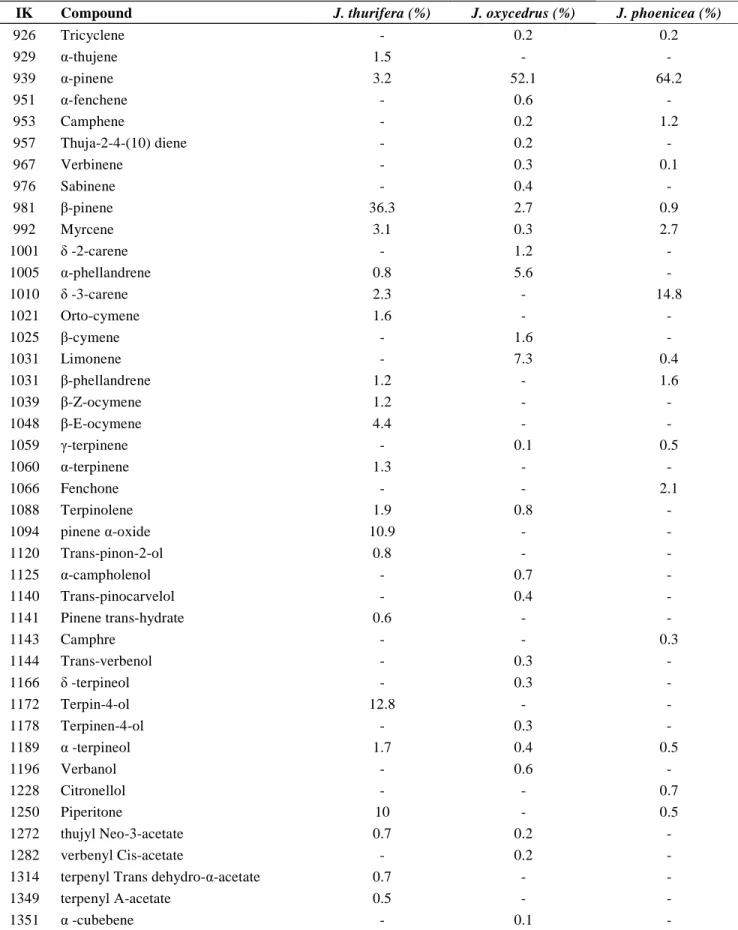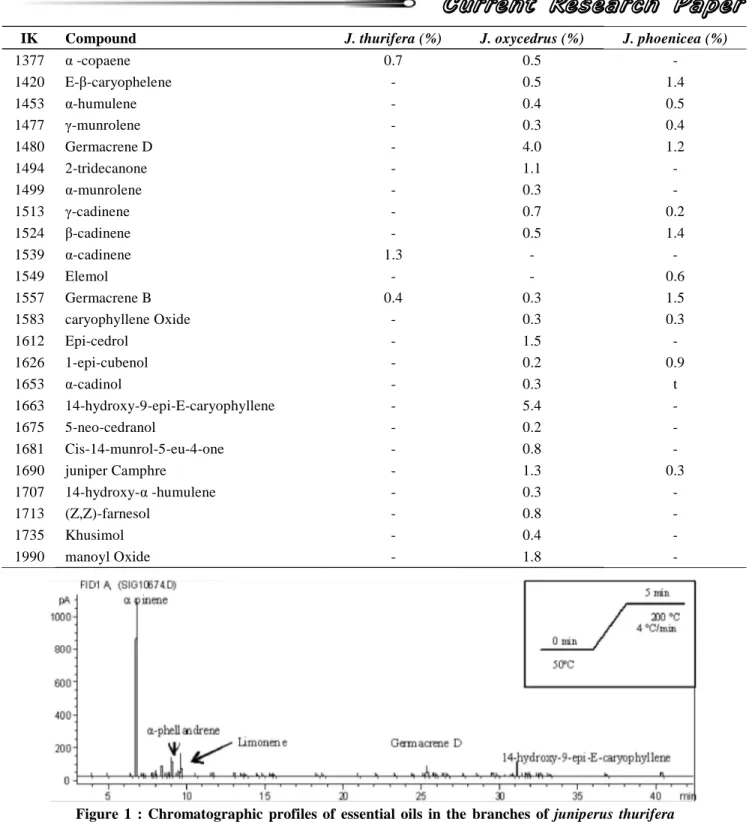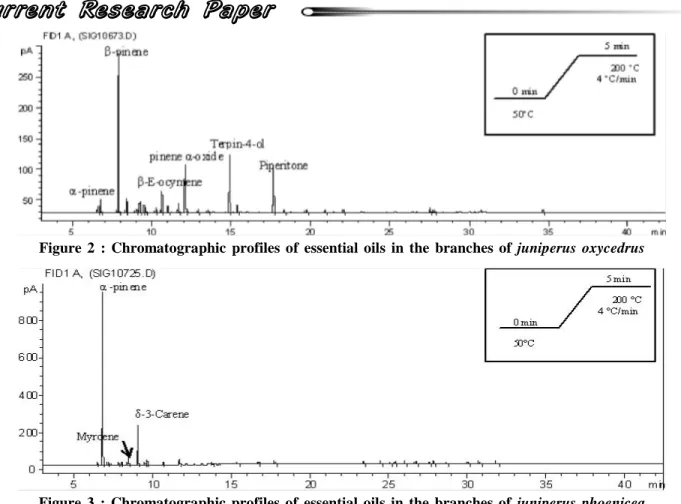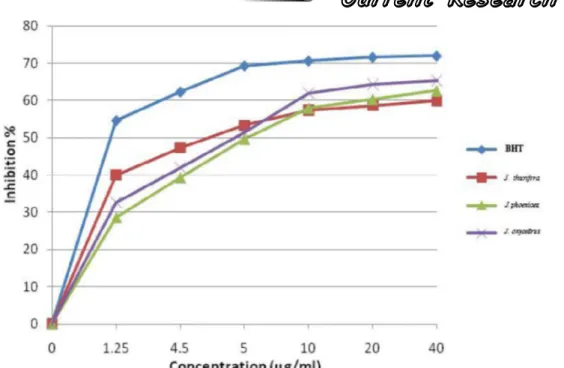HAL Id: hal-01303986
https://hal.archives-ouvertes.fr/hal-01303986
Submitted on 18 Apr 2016HAL is a multi-disciplinary open access archive for the deposit and dissemination of sci-entific research documents, whether they are pub-lished or not. The documents may come from teaching and research institutions in France or abroad, or from public or private research centers.
L’archive ouverte pluridisciplinaire HAL, est destinée au dépôt et à la diffusion de documents scientifiques de niveau recherche, publiés ou non, émanant des établissements d’enseignement et de recherche français ou étrangers, des laboratoires publics ou privés.
Antioxidant properties of essential oils extracted from
three species of moroccan junipers
Badr Satrani, Mohamed Ghanmi, Nazik Mansouri, Nadine Amusant
To cite this version:
Badr Satrani, Mohamed Ghanmi, Nazik Mansouri, Nadine Amusant. Antioxidant properties of es-sential oils extracted from three species of moroccan junipers. Environmental Science : An Indian Journal, 2015, 11 (7), pp.239-247. �hal-01303986�
Current Research Paper
Antioxidant properties of essential oils extracted from three species of
Moroccan junipers
KEYWORDS
Juniperus thurifera; Juniperus oxycedrus; Juniperus phoenicea; Essential oils; Antioxidant activity.ABSTRACT
Essential oils from Juniperus thurifera, Juniperus oxycedrus and
Juniperus phoenicea (Cupressaceae) collected in various areas in
Morocco were extracted by hydrodistillation and analyzed by CG and CG/ SM. Twenty-four components were identified in the essential oils from the branches of Juniperus thurifera, forty seven from Juniperus
oxycedrus and twenty-six from Juniperus phoenicea. The majority
components obtained are pinenes and especially â-pinene (36.3%) for the essential oils from the branches of Juniperus thurifera and á-pinene for those of Juniperus oxycedrus (52.1%) and Juniperus phoenicea (64.2%). The antioxidant properties of oils were determined by the DPPH method and were compared to that found for the reference compound (BHT) and for other essential oils. 2015 Trade Science Inc. - INDIA
INTRODUCTION
The phenomenon of self-oxidation of the lipids produced during the processes of conservation and transformation of food is a very complex purely chemical process, involved in radicalization reac-tions able to self-maintaining and requiring only the presence of atmospheric oxygen. It is responsible of the formation of chemical compounds harmful for the health of the animals as well as men[1].
An antioxidant is a substance which, added to low dose with a naturally oxydable product with the
tion by increasing the time leading to a detectable deterioration of the product[2]. As synthetic antioxi-dants generally used in agribusiness industries are currently questioned in reason of potential toxico-logical risks (e.g., buthylhydroxyanisol (BHA), buthylhydroxytoluene (BHT) and tertiobutylhydroquinone (TBHQ))[3,4], new vegetable sources of natural antioxidant s are thus searched.
Many works, in particular those of Chimi[5,6], at-test the role of some phenolic compounds extracted from virgin olive oils on the good resistance to radicalizing oxidation : the major compounds are
Badr Satrani1*, Mohamed Ghanmi1, Nazik Mansouri1, Nadine Amusant2
1Chemistry and Microbiology laboratories, Forest Research Center, Avenue Omar Ibn El Khattab, BP 763 Agdal, (FRENCH GUIANA)
2CIRAD, Department Environments and Societies, UMR Ecology Forest of French Guiana, BP. 732, 97310 Kourou Cedex, (FRENCH GUIANA)
E-mail: badrsat@yahoo.fr
Environmental Science
An Indian Journal
Volume 11 Issue 7 ESAIJ, 11(7), 2015 [239-247]Environmental Science
ISSN : 0974 - 7451.
240 Antioxidant properties of essential oils extracted from three species of Moroccan junipers
Current Research Paper
ESAIJ, 11(7) 2015
An Indian Journal
Environmental Science
Environmental Science
acid[7]. In this context, the antioxidant properties of the volatile extracts from aromatic plants were largely studied in the aim of protection against the unsaturated fatty acids from animal origin[8]. Thus, an extraction using supercritical CO2 allowed Djamarti and al. (1991)[9] to obtain from rosemary and sage an extract rich in carnosol and ramanol, molecules whose antioxidant capacity can be equiva-lent or even higher than that of BHT.
In this context, the aim of the present work is to evaluate the antioxidant activity of essential oils from the branches of Juniperus thurifera, J. oxycedrus and J. phoenicea collected in various areas of Mo-rocco for the valorization of these three aromatic plants. A comparison with the value found for the compound of reference buthylhydroxytoluene (BHT) was made.
MATERIALS AND METHODS
Plant material
The aerial parts (stems and leaves) of Juniperus
thurifera (thuriferous juniper) and J. oxycedrus were
collected in March (2008). The samples of thuriferous juniper come from Jbel Bouiblane in Eastern Middle-Atlas (Morocco) and those of the J.
oxycedrus from Taffert forest in Eastern
Middle-Atlas (Morocco). The harvest of the samples of
Juniperus phoenicea (red juniper) was carried out
during Mars (2009) in Aghbar forest (High Atlas, Morocco). The taxonomic identification of plant materials was confirmed by A. Aafi, botanist from the Center of forest Research of Rabat, Morocco.
Distillation of essential oils
The isolation of essential oils was achieved by hydrodistillation that was carried out using a Clevenger-type distillation system[10]. The distilla-tion of each sample lasted approximately 4 hours. For each distillation, 200g of fresh raw material was used. Previously, the moisture of the samples was measured in order to calculate the essential oil yields corresponding to 100g of dry matter. Essential oils were dried over anhydrous sodium sulphate and stored at 4°C in the dark until testing and analyzing.
Chromatographic analyses
Gas Chromatographic (GC) analyses were per-formed with a Hewlett-Packard (HP 6890), equipped with a capillary column HP-5 (30m × 0.25mm, 0.25 µm film thickness) and a detector FID at 250°C provided by H2/Air gas mixture and split-splitless injector heated at 250°C. The injection mode is split (with a split ratio of 1/50 and flow at 66 ml/min). The vector gas used is N2 with 1.7 ml/ min. The column temperature was programmed from 50°-200°C at 4°C/min. The apparatus was guided by a computer system type “HP ChemStation,” which manages the apparatus functioning and allows moni-toring of chromatography analyses. The injected vol-ume was about 1 µl. The identification of constitu-ents was achieved on the basis of retention indices and gas chromatography/mass spectrometry (GC/ MS). The GC/MS analyses were performed on a Hewlett-Packard (HP 6890) coupled with a mass spectrometer (HP 5973). Fragmentation was by elec-tron impact under 70 eV field. The column used was a capillary column HP-5MS (5% phenyl methyl si-loxane: 30 m × 0.25 mm, 0.25 µm film thickness). The vector gas was Helium with 1.5 ml/min. The column temperature was programmed from 50°-200°C at 4°C/min. The oil components were identi-fied by comparing the retention indices of authentic materials with those of substances present in the mixture and by further confirming their identities MS (library of NIST 98 spectra).
Antioxidant activity
To evaluate the antioxidant activity, the method of 1,1-diphenyl-2-picrylhydrazyl (DPPH) as de-scribed by Leitao (2002) and Chen (2004) was used[11,12]. The experiment was carried out in a spec-trophotometer (UV/visible) monochromatic (Littrow 1200 lines/mm per stage) of type M550 Camspec, controlled by a computing system with a bidirec-tional numerical interface (RS232C) and a screen of posting LCD backlit (1/4 VGA 320 X 240 pixels) at 517 nm. We prepared the solution of DPPH by the dissolution of 4 mg of the powder in 100 ml of etha-nol (EtOH). The samples of essential oils were pre-pared in EtOH at a rate of 20 µg/ ml. These solu-tions, then underwent dilutions to obtain the
follow-ing concentrations: 1.25, 2.5, 5, 10, 20 and 40 µg/ ml and the test was carried out by mixing 4 ml of DPPH solution with 1 ml of essential oils to be tested with various concentrations. The reference antioxi-dant or positive control (BHT) was also prepared according to the same method. After a 30 min incu-bation period at room temperature, the absorbance was read against a blank at 517 nm. Inhibition free radical DPPH in percent (I %) was calculated as follows[12, 13] :
I% = 100 × (A blank - A
test)/A blank
Where Ablank is the absorbance of the control reac-tion (containing all reagents except the test com-pound), and Atest is the absorbance of the test com-pound. The graph of the percentages of inhibition according to the concentration of essential oil makes it possible to determine the IC50 and the value ob-tained is compared with that found for the compound of reference (BHT).
RESULTS AND DISCUSSION
Yields and chemical composition
The branches of Juniperus thurifera provided the highest yield of essential oils with approximately 1.32% compared to only 0.48% for those from J.
phoenicea and 0.15% for those from J. oxycedrus.
The rate provided by J. thurifera is still higher than that obtained by Akkad and al. (2001)[14] for samples of fruits, leaves and wood from this species and which did not exceed 0.8%. For J. oxycedrus, this rate is lower than that found for the same species in Lebanon (0.72%)[15] and Spain (1.14%)[16]. In con-trast, the rate provided by J. phoenicea, remains higher than those in Greece (0.21%), Spain (0.30%), Egypt (0.36%) and Portugal (0.41%)[17,18].
The compounds identified in essential oils from the branches of three species of junipers are listed in TABLE 1. Twenty for constituents were detected from branches of J. thurifera, 47 of J. oxycedrus and 26 of J. phoenicea. In the thuriferous juniper, the majority compounds of essential oils include the
â-pinene (36.26), in addition to the terpin-4-ol
(12.76%), pinene á-oxide (10.89%), piperitone (10%), â-E-ocymene (4.38%), á-pinene (3.14%) and
myrcene (3.13%) (Figure 1). Those from J.
oxycedrus and J. phoenicea are dominated by
á-pinene with respective rates of 52.13 and 64.19%. We also note the presence in outstanding quantity of limonene (7.32%), á-phellandrene (5.59%), 14-hy-droxy-9-epi-E-caryophyllene (5.44%) and germacrene D (4%) in the essential oils from branches of J. oxycedrus and ä-3-careens (14.84%), myrcene (2.69%) and fenchone (2.12%) in essen-tial oils of J. phoenicea (Figures 2 and 3). In addi-tion, each species shows certain specificities in ter-penic compounds such as the terpin-4-ol (12.76%), pinene á-oxide (10.89%) and â-E-ocymene (4.38%) for the essential oils from J. thurifera, 14-hydroxy-9-epi-E-caryophyllene (5.44%), â-cymene (1.56%) and manoyl oxide (1.82%) for essential oils from J.
oxycedrus and fenchone (2.12%), camphor (0.30%)
and citronellol (0.71%) for essential oils from J.
phoenicea. By their chemical composition, our
es-sential oils extracted from J. thurifera branches are richer in monoterpenes (97.09%) compared to that obtained from fruits of this species studied in Mo-rocco by Akkad and al. (2001) (approximately 60%)[14]. They are also qualitatively similar to that of J. communis of Lithuania and whose principal components identified are â-pinene (39.7%), terpin-4-ol (11.8%), in addition to á-pinene (2.1%) and myrcene (2.0%)[19].
The chemical composition of the essential oil from branches of J. oxycedrus is close to those ob-tained from certain localities in Spain, studied by Velasco-Enegueruela and al. (2003) [20] of which principal components was ápinene (59.8% -86.9%), limonene (1.2% - 2.8%) and D germacrene (0.4% - 3.6%). Our results are slightly different from those of Salido and al. (2002)[16], Adams and al. (1999)[21] and Adams (2000)[22] who found for this species smaller quantities of á-pinene, respectively (40%), (5.1%) and (20.7%), while the rates of D germacrene and manoyl-oxide were much more im-portant.
Another study of J. oxycedrus in Lebanon showed that essential oils also contains as majority components á- pinene with a rate of (27.4%), in ad-dition to myrcene (18.9%), á-phellandrene (7.1%) and limonene (6.7%)[15].
.
242 Antioxidant properties of essential oils extracted from three species of Moroccan junipers
Current Research Paper
ESAIJ, 11(7) 2015
An Indian Journal
Environmental Science
Environmental Science
IK Compound J. thurifera (%) J. oxycedrus (%) J. phoenicea (%)
926 Tricyclene - 0.2 0.2 929 á-thujene 1.5 - - 939 á-pinene 3.2 52.1 64.2 951 á-fenchene - 0.6 - 953 Camphene - 0.2 1.2 957 Thuja-2-4-(10) diene - 0.2 - 967 Verbinene - 0.3 0.1 976 Sabinene - 0.4 - 981 â-pinene 36.3 2.7 0.9 992 Myrcene 3.1 0.3 2.7 1001 ä -2-carene - 1.2 - 1005 á-phellandrene 0.8 5.6 - 1010 ä -3-carene 2.3 - 14.8 1021 Orto-cymene 1.6 - - 1025 â-cymene - 1.6 - 1031 Limonene - 7.3 0.4 1031 â-phellandrene 1.2 - 1.6 1039 â-Z-ocymene 1.2 - - 1048 â-E-ocymene 4.4 - - 1059 ã-terpinene - 0.1 0.5 1060 á-terpinene 1.3 - - 1066 Fenchone - - 2.1 1088 Terpinolene 1.9 0.8 - 1094 pinene á-oxide 10.9 - - 1120 Trans-pinon-2-ol 0.8 - - 1125 á-campholenol - 0.7 - 1140 Trans-pinocarvelol - 0.4 - 1141 Pinene trans-hydrate 0.6 - - 1143 Camphre - - 0.3 1144 Trans-verbenol - 0.3 - 1166 ä -terpineol - 0.3 - 1172 Terpin-4-ol 12.8 - - 1178 Terpinen-4-ol - 0.3 - 1189 á -terpineol 1.7 0.4 0.5 1196 Verbanol - 0.6 - 1228 Citronellol - - 0.7 1250 Piperitone 10 - 0.5 1272 thujyl Neo-3-acetate 0.7 0.2 - 1282 verbenyl Cis-acetate - 0.2 -
1314 terpenyl Trans dehydro-á-acetate 0.7 - -
1349 terpenyl Á-acetate 0.5 - -
1351 á -cubebene - 0.1 -
TABLE 1 : Centesimal chemical composition of essential oils in the branches of juniperus thurifera, J. oxycedrus and J. phoenicea of Morocco
IK Compound J. thurifera (%) J. oxycedrus (%) J. phoenicea (%) 1377 á -copaene 0.7 0.5 - 1420 E-â-caryophelene - 0.5 1.4 1453 á-humulene - 0.4 0.5 1477 ã-munrolene - 0.3 0.4 1480 Germacrene D - 4.0 1.2 1494 2-tridecanone - 1.1 - 1499 á-munrolene - 0.3 - 1513 ã-cadinene - 0.7 0.2 1524 â-cadinene - 0.5 1.4 1539 á-cadinene 1.3 - - 1549 Elemol - - 0.6 1557 Germacrene B 0.4 0.3 1.5 1583 caryophyllene Oxide - 0.3 0.3 1612 Epi-cedrol - 1.5 - 1626 1-epi-cubenol - 0.2 0.9 1653 á-cadinol - 0.3 t 1663 14-hydroxy-9-epi-E-caryophyllene - 5.4 - 1675 5-neo-cedranol - 0.2 - 1681 Cis-14-munrol-5-eu-4-one - 0.8 - 1690 juniper Camphre - 1.3 0.3 1707 14-hydroxy-á -humulene - 0.3 - 1713 (Z,Z)-farnesol - 0.8 - 1735 Khusimol - 0.4 - 1990 manoyl Oxide - 1.8 -
Figure 1 : Chromatographic profiles of essential oils in the branches of juniperus thurifera
The essential oils extracted from branches of J.
phoenicea are richer in á-pinene (64,19%)
com-pared to that obtained from leaves of the same spe-cies studied by Achak and al. (2008) in Marrakech regions (Morocco), and whose content for this com-pound did not exceed 36%[23]. They also differ by their chemical composition of essential oils from red juniper in Tunisia, Greece and Spain whose
con-tent á-pinene is also less important (38.20, 41.8 and 53.5% respectively). On the other hand, we find in the latter more myrcene (4.7, 4.5 and 4% tively), â-phellandrene (2.1, 3.5 and 5.9 % respec-tively)[17, 24]. Oils in subspecies turbinata in Spain and Eumediterranea in Portugal[17]
have á-pinene contents even lower (28.3 and 34.1% respectively), but much higher percentages for â-phellandrene (25.3
.
244 Antioxidant properties of essential oils extracted from three species of Moroccan junipers
Current Research Paper
ESAIJ, 11(7) 2015
An Indian Journal
Environmental Science
Environmental Science
Figure 2 : Chromatographic profiles of essential oils in the branches of juniperus oxycedrus
Figure 3 : Chromatographic profiles of essential oils in the branches of juniperus phoenicea
and 19.2% respectively) and for á-terpenyle acetate (15.5 and 12.5% respectively).
The results obtained are in agreement with those announced by Adams[25] from the analysis of
Juniperus genus, in which pinenes are generally
dominant. These compounds can constitute impor-tant molecules discriminating various species of ju-niper[25]. Moreover, they can also be useful as bio-chemical markers in the genetic study of forests, for the determination of geographical variability of co-nifer species and for the identification of families and clones[26, 27, 28, 19, 30].
Antioxidant activity of essential oils
The measurement of absorbance (optical den-sity C) was taken by spectrophotometry with 517 nm. From the values obtained, we calculated the percentages of inhibition by using the formula given
previously and plotted the graphs in Figure 4, rep-resenting the variations in inhibition percentage ac-cording to the concentration of essential oils. We determined the concentration graphically correspond-ing to 50% of inhibition (IC50), and to the antioxi-dant activity of studied essential oils. By comparing the results of the antioxidant activity with that of com-pounds of reference (BHT), we obtain the values reported in TABLE 2.
It is noted that the essential oils of thuriferous juniper appear antioxidant at a higher level than that of red junipers and Phoenicean junipers. This can be explained by their chemical profiles whose con-tent in oxygenated terpenes is approximately 42%, compared with only 14% for the essential oils of red juniper and approximately 7% for the Phoenicean juniper. This result is also in agreement with sev-eral works[31,32,33] which showed that the antioxidant
TABLE 2 : Antioxidant activity of essential oils in the branches of juniperus thurifera, J. oxycedrus and J. phoenicea in Morocco
Plants J. thurifera J. oxycedrus J. phoenicea BHT
DPPH, IC50 (µg/ml) 4.75 4.90 5.50 1.13
Figure 4 : Antioxydant activity of the essential oils of the branches of juniperus thurifera, juniperus oxycedrus and
juniperus phoenicea and the BHT
properties are in close relationship to the presence of compounds comprising hydroxyl groups. How-ever, it is difficult to assign this activity to the only oxygenated compounds because of the chemical com-plexity of essential oils which can generate a syn-ergy effect between the various compounds.
By studying the antioxidant effect of the essen-tial oils from the fruits of J. oxycedrus in Lebanon, Loizzo and al. (2007)[15] found a value of IC
50 of 7.42
µg/ml, which remains lower than antioxidant capacity
of essential oils from our three species of junipers. A study carried out by Bouzouita and al. (2008)[34] on the antioxidant activity of the essential oils of J.
phoenicea in Tunisia showed that it has also a good
antioxidant potential by reference to the usual anti-oxidant ä-tocopherol. Emami and al. (2007)[35] also identified an important antioxidant effect in several species of the Juniperus genus originating from Iran. The results obtained show that essential oils of junipers reduced free radical DPPH with a good antioxidant potential by reference to the BHT whose value of IC50 is 1.13µg/ml. This value of IC50 ex-presses the concentration of essential oils required to reduce radical DPPH in solution of 50%.
CONCLUSION
The essential oils of branches from the three
stud-ied species of junipers are very rich in pinenes: â-pinene (36.26%) from J. thurifera, á-â-pinene from
J. oxycedrus (52.13%) and J. phoenicea (64.19%).
In comparison with an antioxidant of reference (BHT), essential oils from the three species of juni-pers showed that they are equipped with a good an-tioxidant activity. This characteristic deserves fur-ther investigations for the use of these oils for fur- thera-peutics ones, cosmetics and agribusiness industries.
REFERENCES
[1] J.L.Mau, P.N.Huang, S.J.Huang, C.C.Chen; Anti-oxidant properties of methanolic extracts from two kinds of Introdia camphorata mycelia, Food Chem-istry Journal, 86, 25-31 (2004).
[2] F.O.Gunstone, F.A.Norris; Lipids in foods-chemis-try, Bio-chemistry and technology, Pergamon Press, 161- 63 (1983).
[3] Y.Lu; Antioxidant and radical scavenging activities of polyphenols from apple pomace, Food Chemis-try Journal, 68, 81-85 (2000).
[4] Rice C.A.Evans, J.Sampson, P.M.Bramley,
D.E.Holloway; Why do we expect caroteniods to be antioxidant in-vivo, Free Radic.Res.Journal, 26, 381-398 (1997).
[5] H.Chimi, B.Sadik, M.Le tutour, M.Rahmani; Con-tribution à l’étude comparative des pouvoirs anti-oxidants dans l’huile d’olive du tyrosol, de
.
246 Antioxidant properties of essential oils extracted from three species of Moroccan junipers
Current Research Paper
ESAIJ, 11(7) 2015
An Indian Journal
Environmental Science
Environmental Science
l’hydroxytyrosol, de l’acide cafeique, de l’oleuropein et du BHT, Journal Rev.Fr.Corps Gras., 8/9, 339-344 (1988).
[6] H.Chimi, J.Cillard, P.Cillard, M.Rahmani; Peroxyl
and hydroxyl radical scavenging activity of some
natural phenolic antioxidants,
Am.Oil.Chem.Soc.Journal, 67, 307-312 (1990).
[7] G.Papadopoulos, D.Bokou; Antioxidant effect of
natural phenols on olive, Am.Oil Chem.Soc.Journal,
68, 669-671 (1991).
[8] G.C.Deans, C.R.Noble, Mac A.Pherson, L.Penzes,
G.S.Imre, M.Hofecker; Natural antioxidants from thymus vulgaris (thyme) volatile oil: The beneficial effects upon mammalian lipid metabolism. Skalicky (Eds.), Vienna Ageing Series, Facultas Press, Vienna,
4, 173-76 (1994).
[9] Z.Djamarti, R.M.Jankov, E.Schwirtlich, B.Djulinag,
A.Djordjevic; High antioxidant activity of extracts obtained from sage by supercritical CO2 extraction Am, Oil Chem.Soc.Journal, 68, 731-739 (1991).
[10] J.F.Clevenger; Apparatus for the determination of
volatile oil, Am.Pharm.Assoc.J, 17, 341-346 (1928).
[11] C.N.Chen, M.S.Weng, C.L.Wu, J.K.Lin;
Compari-son of radical scavenging activity, Cytotoxic effects and apoptosis induction in human melanoma cells by taiwanese propolis from different sources, Evid Based Complement Alternat Med.Journal, 1, 175-185 (2004).
[12] G.G.Leitao, S.G.Leitao, W.Vilegag; Quick
prepara-tive separation of natural naphtopyranones with an-tioxidant activity by high-speed counter-current chro-matography, Z.Naturforsch.J, 57, 1051-1055 (2002).
[13] S.Y.Wang, J.H.Wu, L.F.Shyur, L.H.Kuo,
S.T.Chang; Antioxidant activity of abietane-type diterpenes from heartwood of taiwania cryptomerioides hayata, Holzforschung, 56-9 (2002).
[14] S.Akkad, M.Akssira, F.Mellouki, A.F.Barrero;
Quilez Del J.Moral, P.Arteaga, Mar M.Herrador, A.Belgarrab; Etude de la composition des huiles de Juniperus thurifera L.var.africana à l’aide du couplage GC-MS, 2ème Colloque International : Le Genévrier Thurifère et les Forêts d’altitude dans les montagnes du pourtour méditerranéen, Livre des résumés, 58
(2001).
[15] M.R.Loizzo, R.Tundis, F.Conforti, A.M.Saab,
G.A.Statti, F.Menichini; Comparative chemical com-position, Antioxidant and hypoglycaemic activities of Juniperus oxycedrus ssp, oxycedrus L.berry and wood oils from Lebanon, Food Chemistry Journal,
105, 572-578 (2007).
[16] S.Salido, J.Altarejos, M.Nogueras, A.Sanchez,
C.Pannecouque, M.Witvrouw, De E.Clercq; Chemi-cal studies of essential oils of Juniperus oxycedrus ssp, Badia.Ethnopharmacology Journal, 81, 129-134
(2002).
[17] R.P.Adam; Comparison of the leaf essential oils of
Juniperus phoenicea, J.phoenicea subsp, Eu-mediterranea Lebr.& Thiv.And J.phoenicea var.turbinata (Guss.) Parl, Journal Essent.Oil Res.,
8, 367-371 (1996).
[18] El S.A.sawi, H.M.Motawae, A.M.Alib; Chemical
composition, Cytotoxic activity and antimicrobial activity of essential oils of leaves and berries of Juniperus phoenicea L.grown in Egypt, Afr.J.Trad.CAM, 4, 417-426 (2007).
[19] R.Butkienë, O.Nivinskienë, D.Mockutë; Chemical
composition of unripe and ripe berry essential oils of Juniperus communis L. growing wild in Vilnius district, CHEMIJA, 15, 57-63 (2004).
[20] Velasco A.Negueruela, Perez M.J.Alonso, Pala
J.Paul, A.Ínigo, M.Cervera, G.Lopez; Essential oil analyses of the leaves and berries of Juniperus oxycedrus L.subsp.Badia (H.Gay) Debeaux, Botanica, Complutensis, 27, 147-54 (2003).
[21] R.P.Adams, J.Altarejos, C.Fernandez, A.Camacho;
The leaf essential oils and taxonomy of Juniperus oxycedrus, subsp, oxycedrus, subsp, badia (H.GAY) Debeaux, and subsp.Macrocarpa (Sibth.& Sm.) Ball.J.Essent.Oil Res., 11, 17-172 (1999).
[22] R.P.Adams; Systematics of juniperus section
juniperus based on leaf essential oils and random amplified polymorphic DNAs (RAPDs), J.Biochem.Syst.Ecol, 28, 515-528 (2000).
[23] N.Achak, A.Romane, A.Abbad, M.Ennajar,
M.Romdhane, A.Abderrabba; Essential oils compo-sition of juniperus phoenicea from Morocco and Tunisia, J.Essential Oil-Bearing Plants, 11, 137-142
(2008).
[24] H.Medini, A.Elaissi, I.Chraif, F.Bannour, F.Farhat,
Ben M.Salah, M.L.Khouja, R.Chemli; Composition and variability of the essential oils of the leaves from Juniperus phoenicea L.from Tunisia, Acte du séminaire international « les Plantes à Parfum, Aromatiques et Médicinales » SIPAM, Tunisie, 54
(2006).
[25] R.P.Adams; The leaf essential oils and
chemotax-onomy of Juniperus sect Juniperus, J.Biochemical Systematic and Ecology, 26, 637- 645 (1998).
[26] P.H.Baradat, A.Marpeau, J.Walter; Terpene
forest trees, G.Muller-Starck et M.Ziehe (Editions), Sauer Lander’s Verlag, Frankfurt-am-Main, 40
(1991).
[27] J.W.Hanover; Application of terpene analysis in
For-est genetics, New ForFor-ests, 6, 159-178 (1992).
[28] M.Michelozzi, T.L.White, A.E.Squillace, W.J.Lowe;
Monoterpene composition and fusiform rust resis-tance in slash and loblolly pines, Canad.Forest res.Journal, 25, 193-197 (1995).
[29] A.Farah, A.Fechtal, A.Chaouch; Contribution of
chiral gaz chromatography to the chemical charac-terization of essential oils in Eucalyptus hybrids, Ann.Fals.Exp.Chim.J, 957, 387-396 (2001).
[30] M.Ghanmi, B.Satrani, A.Chaouch, A.Aafi, El A.abid,
M.R.Ismaili, A.Farah; Composition chimique et activité antimicrobienne de l’essence de térébenthine du pin maritime (Pinus pinaster) et du pin d’Alep (Pinus halepensis) du Maroc, Acta.Bot.Gallica., 154, 293-300 (2007).
[31] F.Shahidi, D.K.Janitha, P.D.Wanasandura; Critical
Reviews in Food Science and Nutrition, 32 (1992).
[32] L.I.Somava, F.O.Shode, P.Ramnan, A.Nadat;
Anti-hypertensive, Antiatherosclerotic and antioxidant activity of triteneoids isolated from Oléa europaea subspecies African leaves, J.Ethnopharmacol, 84, 299-305 (2003).
[33] S.R.Zhuang, S.L.Chen, J.H.Tsai, C.C.Huang,
T.C.Wu, W.S.Liu, H.C.Tseng, H.S.Lee, M.C.Huang, G.T.Shane, C.H.Yang, Y.C.Shen, Y.Y.Yan, C.K.Wang; Effect of citronellol and the Chinese medical herb complex on cellular immunity of cancer patients receiving chemotherapy/radio-therapy, Phytother.Res., 23, 785-789 (2009).
[34] N.Bouzouita, F.Kachouri, Ben M.Halima,
M.M.Chaabouni; Composition chimique et activités antioxydante, antimicrobienne et insecticide de l’huile essentielle de Juniperus phoenicea, J.Société Chimique de Tunisie, 10, 119-125 (2008).
[35] S.A.Emami, J.Asili, Z.Mohagheghi,
M.K.Hassanzadeh; Antioxidant activity of leaves and fruits of iranian conifers, eCAM, 11, 1-7 (2007).



